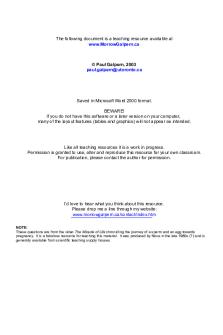Characteristics of Life Answer Key PDF

| Title | Characteristics of Life Answer Key |
|---|---|
| Author | Michael Clinton |
| Course | Perspectives In Life Sciences |
| Institution | University at Albany |
| Pages | 3 |
| File Size | 164.2 KB |
| File Type | |
| Total Downloads | 97 |
| Total Views | 149 |
Summary
Characteristics of Life Answer quiz answer key...
Description
Characteristics of Life Review 1. The daphnia shown below has produced three egg cells, eats live single-celled organisms, lives in freshwater, and is caught and eaten by animals known as hydra.
4. Both a deer and a tree react to changes in their external surroundings, helping them to maintain a constant internal environment. This statement describes a) predation b) homeostasis c) antibiotic resistance d) autotrophic nutrition 5. Which two terms are considered to be opposite processes?
Which terms would most likely be used in a description of this organism? a) asexual reproduction, herbivore, prey, aquatic, heterotrophic b) sexual reproduction, predator, aquatic, heterotrophic, prey c) asexual reproduction, autotrophic, predator, terrestrial, scavenger d) sexual reproduction, carnivore, aquatic, autotrophic, prey 2. Riding a bicycle requires balance and constant adjustment and monitoring by the rider in order to continue cycling. Successfully riding a bicycle most directly results from the ability to a) sexually reproduce b) grow and develop c) detect and respond to change d) metabolize food for energy 3. Organisms undergo constant chemical changes as they maintain an internal balance known as a) interdependence b) homeostasis c) synthesis d) recombination
a) photosynthesis and autotrophic nutrition b) cloning and mitosis c) digestion and synthesis d) dynamic equilibrium and homeostasis 6. The crucian carp, a Scandinavian fish, thrives in shallow ponds that freeze over during winter. While other creatures in the pond die from lack of oxygen, these carp are able to obtain energy through a biochemical pathway that does not require oxygen. This characteristic is an example of a a) feedback mechanism common to carnivores that inhabit shallow pond ecosystems b) favorable adaptive trait that has led to increased survival c) stage of succession that leads to a new community d) gene mutation that occurred because carp need to survive to maintain ecological stability 7. Which phrase best describes cellular respiration, a process that occurs continuously in the cells of organisms? a) removal of oxygen from the cells of an organism b) conversion of light energy into the chemical bond energy of organic molecules c) transport of materials within cells and throughout the bodies of multicellular organisms d) changing of stored chemical energy in food molecules to a form usable by organisms
8. Which process is directly used by autotrophs to store energy in glucose? a) diffusion b) photosynthesis c) respiration d) active transport 9. Some processes that occur in a cell are listed below. A. utilize energy B. detect changes in the environment C. rearrange and synthesize chemical compounds Which processes will all living organisms use to maintain homeostasis? a) A and B, only b) B and C, only c) C and A, only d) A, B, and C 10. Which organ system in humans is most directly involved in the transport of oxygen? a) digestive b) nervous c) excretory d) circulatory 11. Which phrase is an example of autotrophic nutrition? a) a cow eating grass in a field b) a mushroom digesting a dead log c) an apple tree making its own food d) a tapeworm feeding in the body of a dog 12. Why is a mushroom considered a heterotroph? a) It manufactures its own food. b) It divides by mitosis. c) It transforms light energy into chemical energy. d) It obtains nutrients from its environment.
13. In an environment that undergoes frequent change, species that reproduce sexually may have an advantage over species that reproduce asexuallybecause the sexually reproducing species produce a) more offspring in each generation b) identical offspring c) offspring with more variety d) new species of offspring in each generation 14. Which system is correctly paired with its function? a) immune system-intake and distribution of oxygen to cells of the body b) excretory system-remove potentially dangerous materials from the body c) digestive system-transport energy-rich molecules to cells d) circulatory system-produce building block of complex compounds
15. Which diagram best represents the levels of organization in the human body?
(1) (2) (3) (4)
a b c d...
Similar Free PDFs

Characteristics of life
- 3 Pages

Life 2e Advanced SB Answer Key
- 79 Pages

Evidence of Evolution Answer Key
- 9 Pages

Evidence of Evolution Answer Key
- 9 Pages

Articles of Confederation Answer Key
- 10 Pages

Rule of 72 answer key
- 2 Pages

Lab2 Sampling KEY - Answer key
- 9 Pages

Miracle of life 2 ans key
- 5 Pages

Homework #3 KEY - answer key
- 6 Pages
Popular Institutions
- Tinajero National High School - Annex
- Politeknik Caltex Riau
- Yokohama City University
- SGT University
- University of Al-Qadisiyah
- Divine Word College of Vigan
- Techniek College Rotterdam
- Universidade de Santiago
- Universiti Teknologi MARA Cawangan Johor Kampus Pasir Gudang
- Poltekkes Kemenkes Yogyakarta
- Baguio City National High School
- Colegio san marcos
- preparatoria uno
- Centro de Bachillerato Tecnológico Industrial y de Servicios No. 107
- Dalian Maritime University
- Quang Trung Secondary School
- Colegio Tecnológico en Informática
- Corporación Regional de Educación Superior
- Grupo CEDVA
- Dar Al Uloom University
- Centro de Estudios Preuniversitarios de la Universidad Nacional de Ingeniería
- 上智大学
- Aakash International School, Nuna Majara
- San Felipe Neri Catholic School
- Kang Chiao International School - New Taipei City
- Misamis Occidental National High School
- Institución Educativa Escuela Normal Juan Ladrilleros
- Kolehiyo ng Pantukan
- Batanes State College
- Instituto Continental
- Sekolah Menengah Kejuruan Kesehatan Kaltara (Tarakan)
- Colegio de La Inmaculada Concepcion - Cebu






